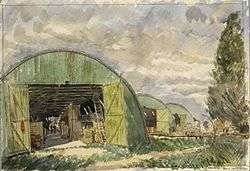Karl Hagedorn (1889–1969)
Karl Hagedorn (11 September 1889 – 1969), who signed himself Hagedorn, was a painter and illustrator. He was born in Berlin in 1889 but settled in Manchester, England, in 1905.[1][2]
Karl Hagedorn | |
|---|---|
| Born | 11 September 1889 |
| Died | 1969 |
| Alma mater | |
| Occupation |
|
| Home town | Berlin |
Biography
Hagedorn was educated in Berlin, and at Manchester School of Technology, Manchester School of Art, the Slade School of Fine Art,[1] and in Paris, under Maurice Denis.[3] Hagedorn became a leading figure in the Manchester art scene showing regularly at the Society of Modern Painters in the city, and also, from 1913 onwards, at the Royal Academy and the New English Art Club.[4] He was naturalised as a British citizen in 1914, and served in the British Army during World War I.[3][5]

Hagedorn provided illustrations for the Empire Marketing Board, Shell and the Radio Times[6] and also worked as a part-time art teacher at Epsom School of Art.[3][5] During World War II, he sold pictures of military subjects to the United Kingdom Government's War Artists' Advisory Committee.[7] During the war, Hagedorn also worked for the Recording Britain project, producing views of Middlesex and Derbyshire, where he lived for a time.[4]
Hagedorn's early works show Cubist and Futurist influences, although he later adopted a more conventional style.[4][3] Some of his works are in the collections of Manchester City Art Gallery,[1] the Victoria and Albert Museum,[1] The Wellcome Library,[8] the Imperial War Museum,[7] and the United Kingdom Government Art Collection holds three examples.[9]
Hagedorn died in 1969.[1] An exhibition, Manchester's First Modernist: Karl Hagedorn 1889-1969, was held at the Whitworth Art Gallery, Manchester, in 1994.[3]
References
- "Karl Hagedorn (Biographical details)". British Museum. Retrieved 30 March 2017.
- "Karl Hagedorn (1889-1969)". Chris Beetles Gallery. 2010. Retrieved 15 June 2017.
- "Karl Hagedorn - Shire Oaks Farm, Chapel en le Frith, Derbyshire 1923". Liss Llewellyn Fine Art Ltd. Retrieved 30 March 2017.
- Gill Saunders (Editor) (2011). Recording Britain. V&A Publishing. ISBN 978-1-85177-661-0.CS1 maint: extra text: authors list (link)
- David Buckman (1998). Artists in Britain Since 1945 Vol 1, A to L. Art Dictionaries Ltd. ISBN 0 95326 095 X.
- "cover". The Radio Times. No. 305. 2 August 1929.
- "Recovery Stores at a RAOC Depot, Feltham (Art.IWM ART LD 5402)". Imperial War Museum. Retrieved 30 March 2017.
- "A home birth. Oil painting by Karl Hagedorn". Wellcome Library. Retrieved 30 March 2017.
- "Government Art Collection - Karl Hagedorn". United Kingdom Government. Retrieved 30 March 2017.
Further reading
- Manchester's First Modernist: Karl Hagedorn 1889-1969. Whitworth Art Gallery. 1994. ISBN 9780903261319.
External links
- 7 paintings by or after Karl Hagedorn at the Art UK site
- Cover of the Summer 1929 edition of The Radio Times, dated August of that year, by Hagedorn
- Portrait sketch of Hagedorn by his friend Randolph Schwabe